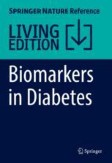Search
Search Results
-
Brain-derived neurotrophic factor and vascular endothelial growth factor A: biomarkers potential in diabetes
Previously, brain-derived neurotrophic factor (BDNF) and vascular endothelial growth factor (VEGF) have been studied only in diabetic neuropathy or...
-
ATF3 in atherosclerosis: a controversial transcription factor
AbstractAtherosclerosis, the pathophysiological basis of most malignant cardiovascular diseases, remains a global concern. Transcription factors play...

-
Hydrogen peroxide induced by nerve injury promotes axon regeneration via connective tissue growth factor
Regeneration of the neuromuscular junction (NMJ) leverages on extensive exchange of factors released from motor axon terminals (MATs), muscle fibers...

-
MiR-15p-5p Mediates the Coordination of ICAM-1 and FAK to Promote Endothelial Cell Proliferation and Migration
Intercellular adhesion molecule-1 (ICAM-1) in endothelial cells is critical for neutrophil adhesion and transmigration across the endothelium. Focal...

-
Role of FSH and FSH receptor on HUVECs migration
Follicle-stimulating hormone (FSH) is a pituitary glycoprotein that regulates follicle maturation through its binding to follicle-stimulating hormone...

-
Role of the pioneer transcription factor GATA2 in health and disease
The transcription factor GATA2 is involved in human diseases ranging from hematopoietic disorders, to cancer, to infectious diseases. GATA2 is one of...

-
Targeting the oncogenic transcription factor FOXM1 to improve outcomes in all subtypes of breast cancer
FOXM1 (Forkhead box M1) is an oncogenic transcription factor that is greatly upregulated in breast cancer and many other cancers where it promotes...

-
RETRACTED ARTICLE: IFIT1 modulates the proliferation, migration and invasion of pancreatic cancer cells via Wnt/β-catenin signaling
Abstract ObjectivesPreviously, Interferon-induced Protein with Tetratricopeptide Repeats 1 (IFIT1) has been shown to promote cancer development....

-
Gα13 Contributes to LPS-Induced Morphological Alterations and Affects Migration of Microglia
Microglia are the resident immune cells of the CNS that are activated in response to a variety of stimuli. This phenotypical change is aimed to...

-
Neuropeptide α-Melanocyte-Stimulating Hormone Promotes Neurological Recovery and Repairs Cerebral Ischemia/Reperfusion Injury in Type 1 Diabetes
Persons with type 1 diabetes have an increased risk of stroke compared with the general population. α-Melanocyte-stimulating hormone (α-MSH) is a...

-
The LIN28B/TGF-β/TGFBI feedback loop promotes cell migration and tumour initiation potential in cholangiocarcinoma
Cholangiocarcinoma (CCA), a lethal malignancy of the biliary epithelium, is the second most common primary liver cancer. The poor prognosis of CCA is...

-
Oncogenic functions of the FOXC2 transcription factor: a hallmarks of cancer perspective
Epigenetic regulation of gene expression is a fundamental determinant of molecular and cellular function, and epigenetic reprogramming in the context...

-
Overexpression of the nucleoporin Nup88 stimulates migration and invasion of HeLa cells
Elevated expression of the nucleoporin Nup88, a constituent of the nuclear pore complex, is seen in various types of malignant tumors, but whether...

-
Association of interleukin-17A and chemokine/vascular endothelial growth factor-induced angiogenesis in newly diagnosed patients with bladder cancer
BackgroundThe human interleukin-17 (IL-17) family comprises IL-17A to IL-17 F; their receptors are IL-17RA to IL-17RE. Evidence revealed that these...

-
Cell plasticity modulation by flavonoids in resistant breast carcinoma targeting the nuclear factor kappa B signaling
Cancer cell plasticity plays a crucial role in tumor initiation, progression, and metastasis and is implicated in the multiple cancer defense...

-
Fibroblast growth factor pathway promotes glycolysis by activating LDHA and suppressing LDHB in a STAT1-dependent manner in prostate cancer
BackgroundThe initiation of fibroblast growth factor 1 (FGF1) expression coincident with the decrease of FGF2 expression is a well-documented event...

-
Transcription Factor HEY1 Improves Brain Vascular Endothelial Cell Function and Alleviates Ischemic Stroke by Upregulating NOTCH3
To investigate the function of hairy/enhancer-of-split related with YRPW motif protein 1 (HEY1) and Notch receptor 3 (NOTCH3) in ischemic stroke....

-
Candidalysin, a Virulence Factor of Candida albicans, Stimulates Mast Cells by Mediating Cross-Talk Between Signaling Pathways Activated by the Dectin-1 Receptor and MAPKs
PurposeAlthough mast cells (MCs) modulate the activity of effector cells during Candida albicans infection, their role in the pathogenesis of...

-
Congenital Neutropenia and Migration Defects
Congenital conditions caused by an absolute or functional deficiency of neutrophils are associated with considerable morbidity and mortality in...
-
Pleiotrophin selectively binds to vascular endothelial growth factor receptor 2 and inhibits or stimulates cell migration depending on ανβ3 integrin expression
Pleiotrophin (PTN) has a moderate stimulatory effect on endothelial cell migration through α ν β 3 integrin, while it decreases the stimulatory effect...

